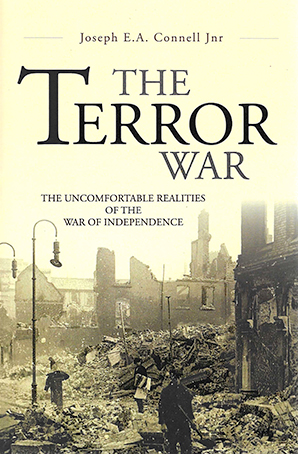THE TERROR WAR: THE UNCOMFORTABLE REALITIES OF THE WAR OF INDEPENDENCE
Published in Book Reviews, Book Reviews, Issue 2 (March/April 2022), Reviews, Volume 30 JOSEPH E.A. CONNELL Jnr
JOSEPH E.A. CONNELL Jnr
Eastwood Books
€20
ISBN 9781913934200
Reviewed by Thomas Earls Fitzgerald
Thomas Earls Fitzgerald is the author of Combatants and civilians in revolutionary Ireland, 1918–1923 (Routledge, 2021).
In late October/early November 1920 the Kerry IRA orchestrated a county-wide series of attacks against the Royal Irish Constabulary. In response, the recently deployed Black and Tans conducted an unprecedented number of vicious attacks on civilians across Kerry. In one incident, Black and Tans came to the home of IRA man James Houlihan near the north Kerry town of Ballyduff. Houlihan was taken from the house and shot dead—his mother was also dragged outside and made to watch. In some respects this one incident encapsulates much of the brutal, symbolic and even performative nature of violence in Ireland: the perpetrators were specifically punishing the Houlihans but the killing was also meant as a warning of what lay in store for Irish republicans, their families and the wider community if violence continued. It is these questions concerning the intent of political violence in Ireland, alongside its morality and legacy, that are central to Joseph E.A. Connell Jr’s new volume.
Connell has long been a chronicler of the 1916–21 period, with volumes published on the 1916 Rising, key locations in revolutionary Dublin and Michael Collins. In this new addition Connell looks at both insurgency and counter-insurgency, and specifically how Irish republican separatists and Crown forces used ‘terror’ to achieve their aims. Connell particularly examines Bloody Sunday, reprisals by Crown forces, the killing of spies and informers, and violence against women. This book has much to commend it: it shows a clear understanding of the period, together with the available sources and historiography. It rightly places women’s experience as central to understanding the revolution, and intelligently considers the subsequent trauma experienced by veterans.
The book is largely focused on Dublin, and on the role of Michael Collins in particular—which is both a plus and a negative. Connell presents the IRA, with Collins at their head, as having a seemingly coherent strategy of controlled terrorism, as opposed to the confused and poorly implemented violence of their opponents. Connell contends that Collins’s strategy largely succeeded, as the IRA secured considerable concessions whereas the British did not. The case for a larger strategy may appear to be so in hindsight, however; Collins had limited influence over IRA units outside of Dublin, who played a crucial role in the escalation of the conflict. Indeed, much of the violence of rural IRA units was based on initiative, expediency and proactive leaders rather than anything resembling strategy. In rural Ireland also, many of the methods of the IRA were drawn from older traditions of agrarian agitation rather than driven by the leadership or by a conscious decision to adopt terrorist methods.
Connell’s central contention is that the IRA’s ‘terrorist’ methods had the backing of the civilian community, whereas British terrorist methods did not. Connell recognises that intimidation of Irish civilians by the IRA did occur but argues that it may have been unnecessary, as the IRA largely had the support of the people in any case. New research shows, however, that the IRA were far more likely to engage in the intimidation of civilians than in attacks on their armed opponents. This intimidation was often brutal, personalised and frequently intended as a warning to the population at large—much like the violence of the Crown forces. Whether such intimidation was necessary or not is up for debate, but the sheer frequency of such acts suggests that the IRA were unsure of the loyalty of the civilian population.
Conversely, Connell argues that British violence drove more people towards supporting the IRA, worsened Britain’s international image, was becoming increasingly expensive and ultimately led the British to the negotiating table. However, whether this was a premeditated policy on the part of the IRA leadership or whether they were reacting to and analysing changing circumstances is again debatable. Regardless, the concept of an IRA driven by an entirely calculating approach to their violence proved not to be lasting. The 1916 Rising, while clearly designed to have a considerable political impact, was also driven by themes such as theatricality, sacrifice and martyrdom. The influence of this approach is seen when the anti-Treaty IRA reverted to the 1916 model by occupying the Four Courts in 1922—which should be seen as a symbolic rather than a practical means of resisting the Treaty. Perhaps some did not learn the lessons of 1919–21?
Connell sees particular interest in how modern interpretations of terrorism relate to the 1919–21 conflict. However, Ulster in this period—with its indiscriminate killings, sectarianism, population displacement and various paramilitaries, which closely resembles modern terrorist conflicts—comes under almost no sustained scrutiny. Occasionally, the modern rhetoric regarding terrorism does not quite work, particularly in Connell’s decision to use the term ‘radicalisation’.
On a broader point, Connell is clearly interested in understanding violence, but this is sometimes at the expense of the larger political considerations. Very little is said of Sinn Féin’s electoral success at local or national level, Labour’s vital support for the republican project, or the successful establishment of the counter-state in 1919–20. The counter-state was particularly damaged by the deployment and subsequent violence of the Black and Tans in 1920, as the various elements of the Dáil government, particularly the courts, could no longer operate in safety. This transformed the Irish revolution into a largely violent process, as the IRA in retaliation became more militarised and brutal as 1920 moved into 1921. As all these elements tie in and were affected by violence, it could be argued that no aspect of the Irish revolution should be seen in isolation.
















